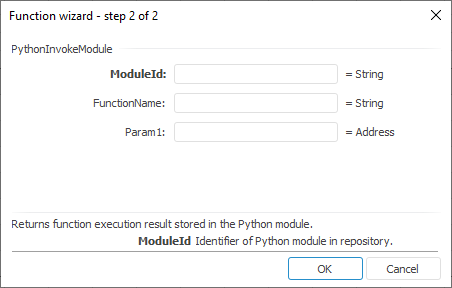
The function wizard for the PythonInvokeModule function looks as follows:

PythonInvokeModule(ModuleId, FunctionName, Param,…)
ModuleId. Python module identifier in repository.
FunctionName. Executed function name.
Param1, Param2, …, ParamN. Parameters sent to function.
NOTE. To define the parameter, specify either the number or the address of the cell where it is located.
It returns function execution result stored in the Python module.
NOTE. Before using the function, make sure that integration between Foresight Analytics Platform with Python is executed.
The function can contain several parameters. New formulas are added automatically in the formula wizard after the user puts the cursor into the field with parameter. If extra parameters are added, they should be left empty. If the function contains no parameters, leave the Param field empty.
Keep in mind the following when calling a Python function:
Executed function name is case-sensitive.
Parameters of the function and returned result must have one of the following data types: Null, Boolean, Integer, Double, Decimal (applied only to the result returned by the function), String
If input and output operations are used in the module, then use the mechanism of critical sections for them.
TIP. For details on writing functions in the Python language and on import of modules into the Python library, see Python documentation.
Consider the Python code contained in the Python module with the MOD_PYT identifier:
def calculate(a, b)
return b%a+a
def check(value)
if (value>1000):
return 1
else
return 0
The table contains examples of formulas using the PythonInvokeModule function:
| Formula | Result | Description |
| =PythonInvokeModule("MOD_PYT", "calculate", 4, 40) | 4 | Calling the calculate function from the Python module in repository with the MOD_PYT identifier. Fixed values are sent as parameters values. |
| =PythonInvokeModule("MOD_PYT", "check", C3) | 1 OR 0 | Calling the check function from the Python module in repository with the MOD_PYT identifier. The C3 cell value is sent as parameter value. If the cell value is greater than 1000, then 1 is returned, otherwise - 0. |
See also: